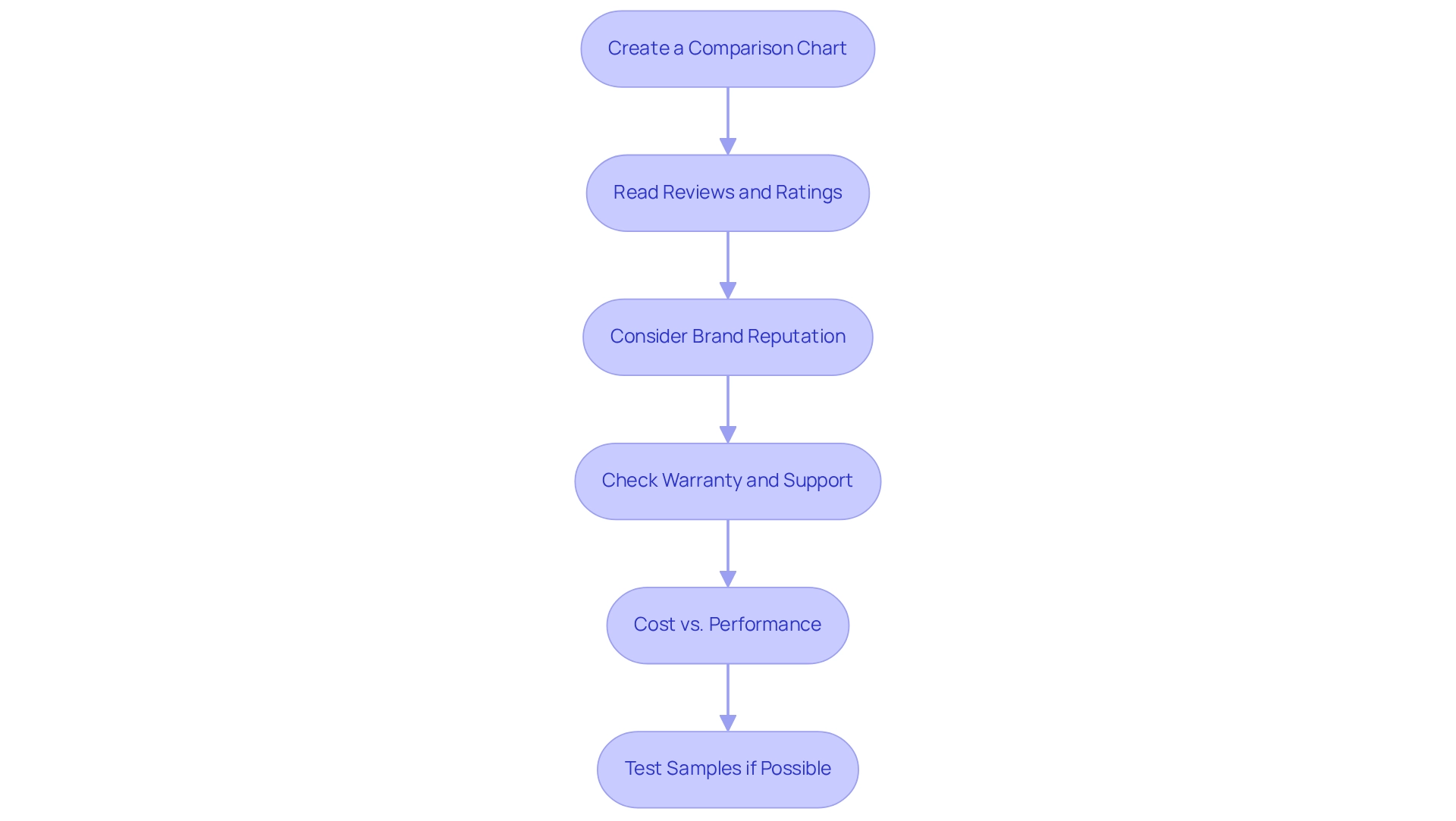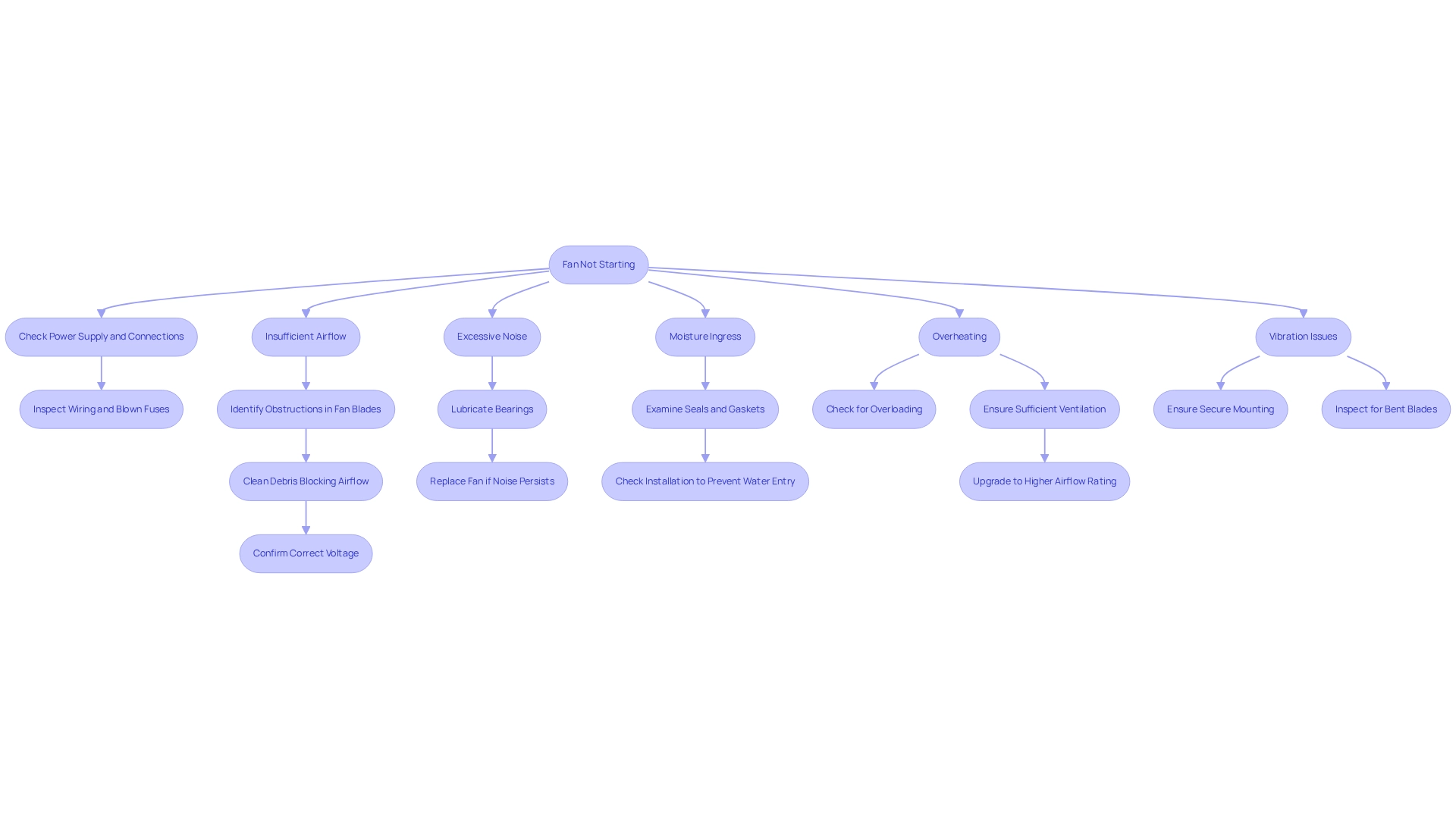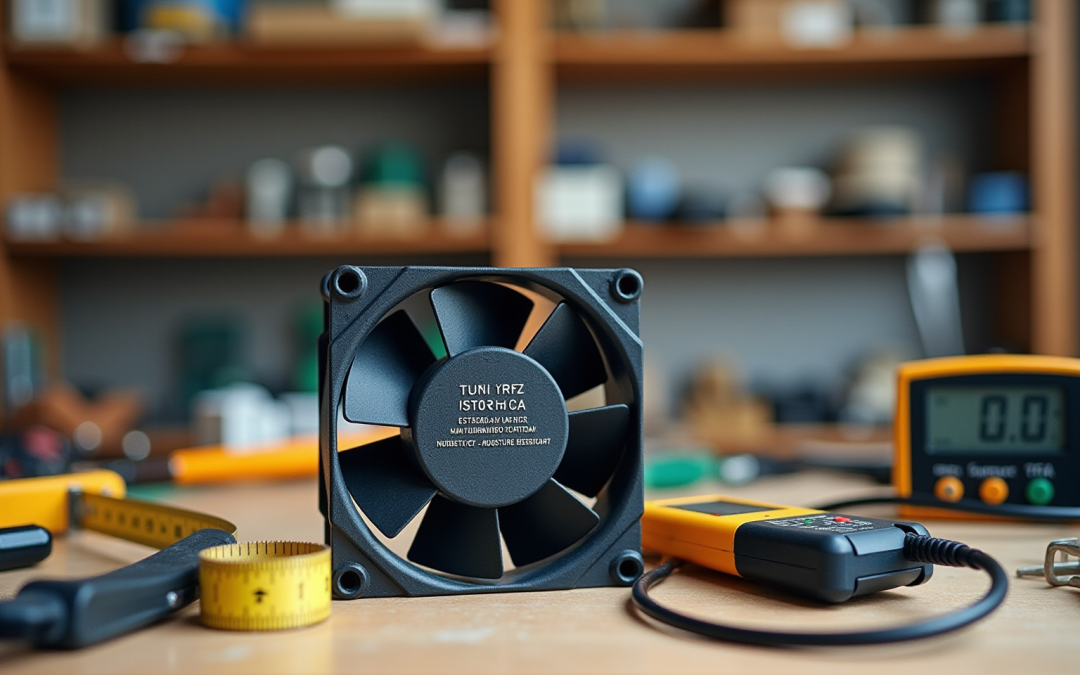Overview
The primary focus of this article is to optimize the integration of small waterproof fans through a systematic evaluation of critical specifications. It identifies essential factors such as:
- Airflow rate
- Size
- Power consumption
- IP rating
- Noise level
- Material durability
These considerations are paramount for ensuring effective cooling and reliability across various electronic applications, especially in challenging environments. By addressing these specifications, we can enhance performance and extend the lifespan of electronic devices.
Introduction
In the realm of electronics, the significance of effective cooling solutions is paramount, especially regarding waterproof fans. These specialized components are engineered to excel in environments where moisture and dust present considerable challenges, rendering them indispensable for a wide array of applications—from outdoor devices to industrial machinery.
Grasping the essential specifications for selecting the appropriate waterproof fan is vital for maximizing performance and reliability. This article investigates the critical factors to consider, examines the varied applications of waterproof fans, and offers insights on assessing different models.
Furthermore, it addresses prevalent issues that may emerge and provides troubleshooting strategies to ensure optimal operation, ultimately enhancing the longevity and efficiency of electronic systems.
Identify Key Specifications for Waterproof Fans
To enhance the integration of small waterproof fan devices, it is crucial to determine the key specifications that will best suit your application. Consider the following critical factors:
- Airflow Rate (CFM): Assess the required airflow in cubic feet per minute (CFM) based on the cooling needs of your electronic components. Fans with higher CFM ratings provide superior cooling performance, which is vital for maintaining optimal operating temperatures. Significantly, blade pitch is important; devices with a pitch of 14° or more can move 40% more air than flat blades, making them a crucial consideration in your selection.
- Size and Form Factor: Measure the available installation space to ensure the fan dimensions fit without obstructing other components. Gagner-Toomey Associates provides a wide range of moisture-resistant and dust-resistant devices, featuring sizes from 15mm to 280mm, guaranteeing effective airflow and overall system efficiency.
- Power Consumption: Review the voltage and wattage requirements to ensure compatibility with your power supply. Choosing devices with lower power consumption not only decreases energy expenses but also reduces heat production within the system. On average, waterproof ventilators in electronics consume around 1 to 10 watts, providing a benchmark for engineers when making selections.
- Ingress Protection (IP) Rating: Select devices with appropriate IP ratings, like IP67 or IP68, which signify their resistance to dust and moisture. This specification is essential for ensuring the longevity and reliability of devices in wet or dusty environments. Gagner-Toomey Associates provides a wide range of small waterproof fans and dustproof ventilators optimized for efficacy and effectiveness, guaranteeing they satisfy the stringent requirements of diverse applications.
- Noise Level: Evaluate the noise output of the fan, particularly for applications where sound levels are a concern. Look for specifications that detail decibel levels (dB) to ensure the fan operates within acceptable limits.
- Material and Durability: Investigate the materials used in the fan’s construction. To ensure durability over time, a small waterproof fan should be constructed from corrosion-resistant substances like high-quality plastics or metals to withstand harsh conditions. Gagner-Toomey Associates offers devices made from robust materials intended to endure tough conditions.
In a recent case study, multiple clients conveyed contentment with their cooling solutions from Gagner-Toomey Associates, highlighting their efficiency in maintaining electronics at a low temperature. This favorable response suggests a robust market for dependable cooling products, with numerous users ready to buy again.
By carefully evaluating these specifications, you can choose a resistant fan that efficiently fulfills the requirements of your use case, improving both performance and dependability. After selecting the appropriate fan specifications, consider the next steps for implementation or further research to ensure optimal integration.

Explore Applications of Small Waterproof Fans in Electronics
Small waterproof fans play a crucial role in various electronic applications, particularly in environments where humidity and dust pose significant challenges. The following are key applications:
- Outdoor Electronics: Devices such as weather stations, outdoor cameras, and environmental sensors rely on moisture-resistant ventilators to maintain optimal operating temperatures, ensuring durability and reliability in harsh conditions. The market for these solutions is expanding, with the Manhole Monitoring System Market projected to reach USD 2 Billion by 2024, indicating a growing demand for technologies such as small waterproof fans in outdoor electronics.
- In the realm of boats and marine electronics, a small waterproof fan is essential for cooling components while resisting saltwater corrosion, a vital aspect for sustaining performance in marine settings. Insights from the case study titled “Growth Drivers of Marine Centrifugal Fans Market” reveal that the market has experienced growth due to increasing demand across diverse applications and end-user industries worldwide.
- Industrial Machinery: Equipment used in manufacturing processes that involve liquids or high humidity levels benefits significantly from using small waterproof fans, which help prevent overheating and enhance operational efficiency.
- HVAC Systems: Within HVAC systems operating in moist conditions, a small waterproof fan is essential for ensuring effective airflow and cooling, thereby improving overall system efficacy and energy efficiency.
- In automotive applications, moisture-resistant cooling devices, such as a small waterproof fan, are employed in engine compartments and other damp areas to uphold performance and reliability, particularly under adverse weather conditions.
- Medical Devices: Portable medical devices that may encounter spills or moisture require a small waterproof fan to ensure safe operation, highlighting the importance of reliability in critical applications.
Joel John, Manager – International Business and Partner Relations, emphasizes, “We will be glad to assist you in case you have any additional questions, so feel free to get in touch,” highlighting the value of expert guidance in selecting the appropriate fan for specific requirements.
Understanding these applications is vital for choosing the right small waterproof fan, which ensures effective cooling and protection against environmental factors. As the market for small waterproof fans continues to grow, driven by increasing demand across multiple industries, the integration of these fans into electronic systems will become increasingly critical for performance and durability. Additionally, the application-oriented segmentation of the Marine Fans Market elucidates key demand factors and potential growth areas, further underscoring the significance of resilient fans in today’s electronics landscape.
Evaluate and Compare Waterproof Fan Models
To effectively evaluate and compare different waterproof fan models, consider the following steps:
- Create a Comparison Chart: Compile a comprehensive list of potential fan models, detailing their specifications, including airflow rate, size, power consumption, IP rating, and noise level. This visual aid will facilitate a swift assessment of the options available.
- Read Reviews and Ratings: Investigate user reviews and expert ratings to gain insights into the performance and reliability of each model. Pay particular attention to feedback regarding durability in wet conditions, as this is critical for waterproof applications.
- Consider Brand Reputation: Research the manufacturers behind the devices. Established brands typically boast a proven track record of quality and customer service, which can significantly influence your decision-making process.
- Check Warranty and Support: Evaluate the warranty offered by the manufacturer. A longer warranty often signifies confidence in the product’s durability and can provide peace of mind.
- Cost vs. Performance: Analyze the cost of each model in relation to its specifications. Investing in a higher-quality fan may yield long-term savings through reduced maintenance and replacement costs.
- Test Samples if Possible: If feasible, acquire samples of the fans for practical testing in your specific use case. This hands-on evaluation can uncover insights that specifications alone may not reveal.
By systematically evaluating and comparing these models, you will be able to identify the waterproof fan that best meets your requirements, ensuring optimal performance in both indoor and outdoor settings. For instance, the Lasko 7050 Misto, while not battery-operated, is well-suited for outdoor activities like camping, underscoring the importance of selecting the right fan for specific applications. Furthermore, with the increasing variety of fan styles available today, including battery-operated and stand-up models equipped with advanced features such as air filtration and thermostat control, the options are more diverse than ever, allowing for tailored solutions to meet unique needs. As Kaivaan Kermani remarked, “Today, enthusiasts arrive in a variety of styles,” highlighting the importance of considering these choices in your assessment. Additionally, the Westinghouse Lighting Oasis Ceiling Fan can cool a space of up to 225 square feet, providing a concrete example of the metrics to consider when comparing fan models.

Troubleshoot Common Issues with Waterproof Fans
Even the most dependable moisture-resistant devices can encounter problems over time. Understanding these issues is crucial for maintaining optimal performance. Here are some common problems along with effective troubleshooting tips:
- Fan Not Starting: Start by checking the power supply and connections. Ensure that the fan is correctly wired and inspect for any blown fuses.
- Insufficient Airflow: Identify obstructions in the fan blades or housing. Clean any debris that may be blocking airflow, and confirm that the fan is operating at the correct voltage.
- Excessive Noise: Noisy operation may indicate worn bearings or debris within the fan. Lubricate the bearings if applicable, or consider replacing the fan if the noise persists.
- Moisture Ingress: If moisture is detected inside the fan, examine the seals and gaskets for damage. Proper installation is crucial to prevent water entry.
- Overheating: If the fan is overheating, check that it is not overloaded and that it has sufficient ventilation. Upgrading to a fan with a higher airflow rating may be necessary.
- Vibration Issues: Excessive vibration can result from an unbalanced fan or improper mounting. Ensure the fan is securely mounted and inspect for any bent blades.
By following these troubleshooting steps, you can significantly enhance the performance and reliability of your small waterproof fan, ensuring it operates effectively in challenging environments. Statistics indicate that proper upkeep can substantially prolong the lifespan of these devices. To attain a life expectancy of no less than 80,000 hours, each of the 30 devices should be assessed for 68,280 hours. As Alan Claassen noted, “We hope the material presented here will help encourage standardization in fan life evaluation.” This proactive approach not only mitigates common issues but also promotes longevity in fan operation. Additionally, it’s worth noting that AC fans operate without brushes, which reduces maintenance needs and increases lifespan, further emphasizing the importance of regular evaluation and maintenance.

Conclusion
Selecting the right waterproof fan is essential for achieving optimal performance across various electronic applications. Understanding key specifications—such as airflow rate, size, power consumption, ingress protection ratings, noise levels, and material durability—enables the selection of fans that not only fulfill cooling requirements but also endure challenging environments. This article underscores the significance of these specifications and demonstrates how they enhance the longevity and reliability of electronic systems.
Waterproof fans are extensively utilized in multiple sectors, including:
- Outdoor electronics
- Marine equipment
- Industrial machinery
- HVAC systems
- Automotive applications
- Medical devices
As the demand for these specialized components continues to rise, recognizing their diverse applications becomes critical for making informed decisions that improve operational efficiency and safeguard sensitive equipment against environmental threats.
Furthermore, evaluating and comparing various fan models through practical assessments, reviews, and brand reputation is crucial to ensure that the selected fan meets specific application requirements. Addressing common issues, such as inadequate airflow and excessive noise, is equally vital for sustaining fan performance over time. By implementing these strategies, users can optimize the effectiveness and lifespan of their waterproof fans. Ultimately, this reinforces the central message: investing in the right cooling solutions is imperative for enhancing the reliability and efficiency of electronic systems in any environment.
Frequently Asked Questions
What is the importance of the airflow rate (CFM) in selecting a waterproof fan?
The airflow rate, measured in cubic feet per minute (CFM), is crucial for determining the cooling needs of electronic components. Fans with higher CFM ratings offer better cooling performance, which helps maintain optimal operating temperatures. Additionally, a blade pitch of 14° or more can move 40% more air than flat blades.
How should I determine the size and form factor of a waterproof fan?
Measure the available installation space to ensure that the fan dimensions fit properly without obstructing other components. Gagner-Toomey Associates offers a variety of moisture-resistant and dust-resistant fans ranging from 15mm to 280mm in size.
Why is power consumption an important factor when choosing a waterproof fan?
Reviewing the voltage and wattage requirements is essential for compatibility with your power supply. Selecting devices with lower power consumption reduces energy costs and minimizes heat production in the system. Typically, waterproof ventilators consume between 1 to 10 watts.
What does the ingress protection (IP) rating signify for waterproof fans?
The IP rating indicates the level of resistance to dust and moisture. Ratings like IP67 or IP68 are recommended for ensuring the longevity and reliability of fans in wet or dusty environments. Gagner-Toomey Associates provides fans that meet these stringent requirements.
How can I assess the noise level of a waterproof fan?
Evaluate the noise output by checking the specifications for decibel levels (dB). This is particularly important for applications where sound levels are a concern, ensuring the fan operates within acceptable limits.
What materials should I look for in a durable waterproof fan?
Investigate the materials used in the fan’s construction. A durable waterproof fan should be made from corrosion-resistant substances, such as high-quality plastics or metals, to withstand harsh conditions. Gagner-Toomey Associates offers fans constructed from robust materials designed for durability.
What feedback have clients provided regarding cooling solutions from Gagner-Toomey Associates?
Clients have expressed satisfaction with their cooling solutions from Gagner-Toomey Associates, noting their efficiency in keeping electronics at low temperatures. This positive feedback indicates a strong market for reliable cooling products, with many users willing to make repeat purchases.
What should I do after selecting the appropriate fan specifications?
After choosing the right fan specifications, consider the next steps for implementation or further research to ensure optimal integration of the fan into your application.

